
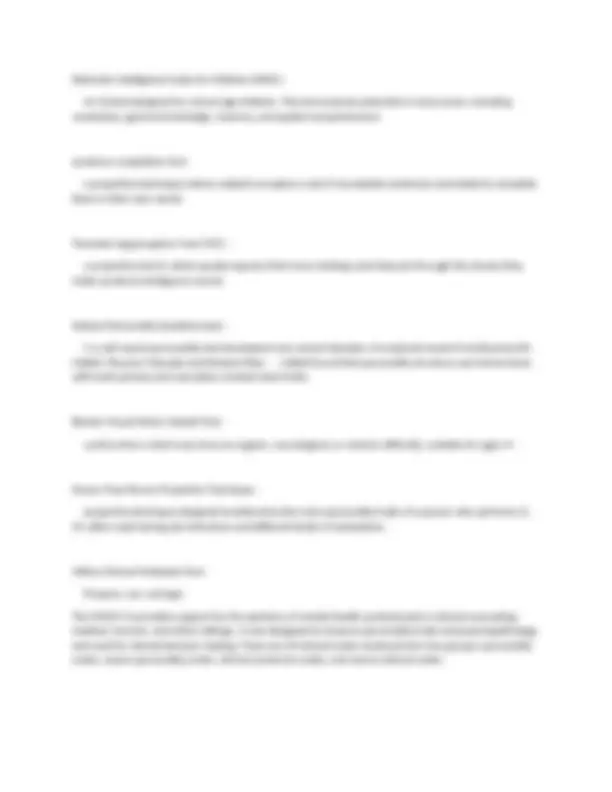
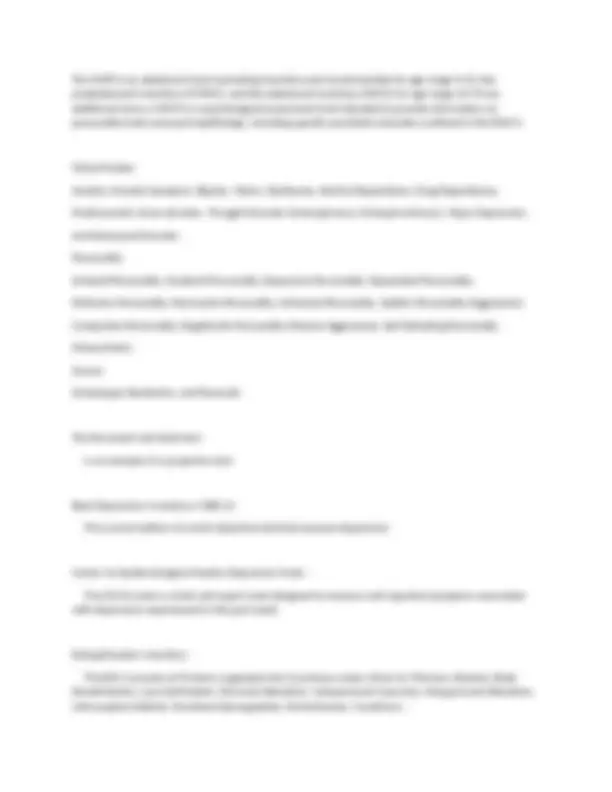
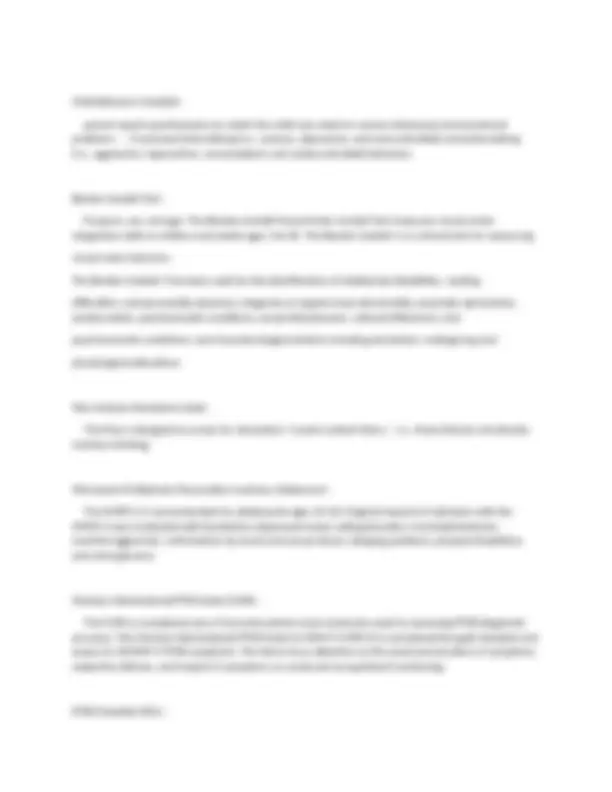
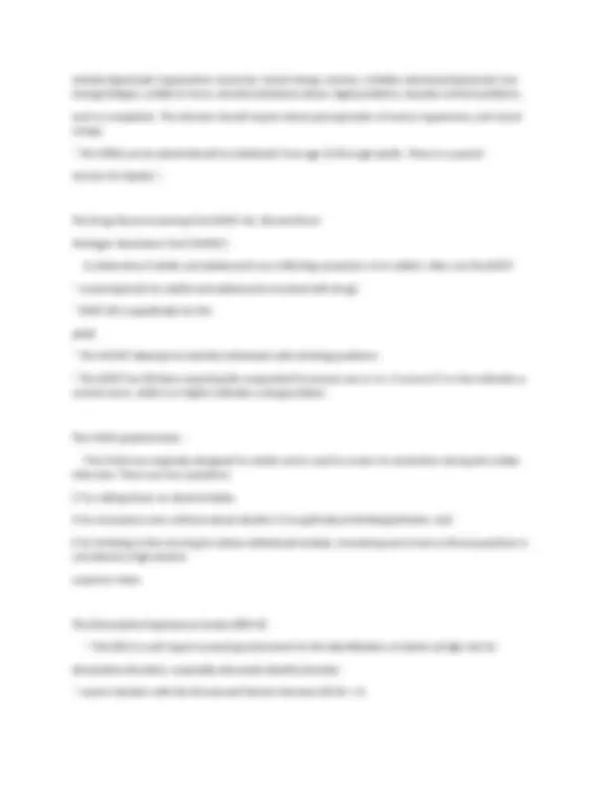
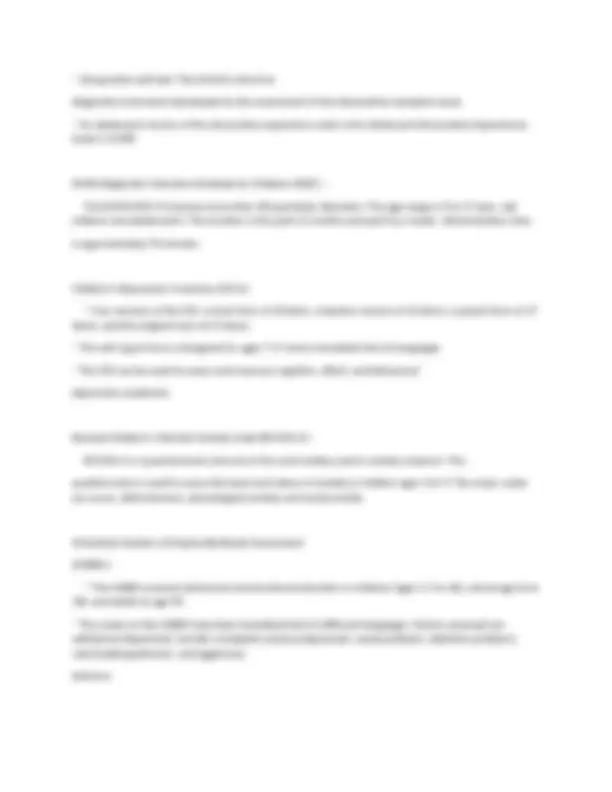
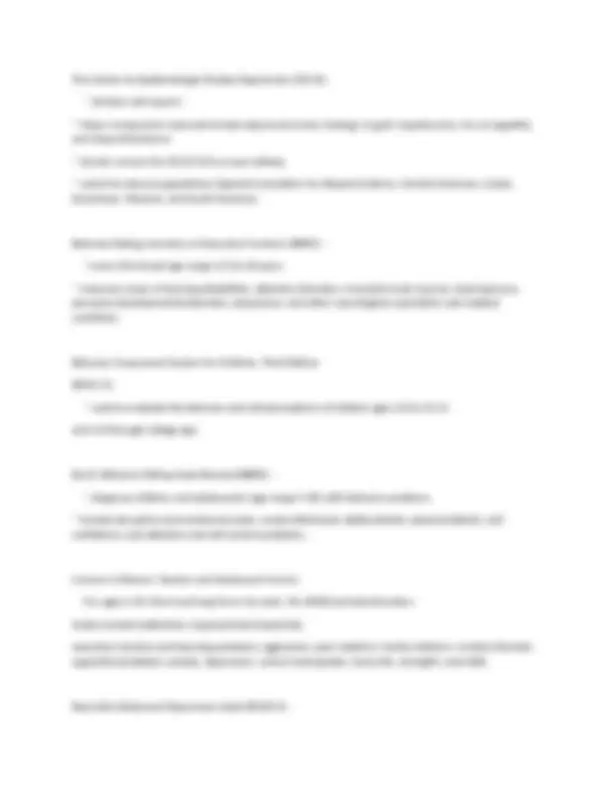


Study with the several resources on Docsity

Earn points by helping other students or get them with a premium plan


Prepare for your exams
Study with the several resources on Docsity

Earn points to download
Earn points by helping other students or get them with a premium plan
Community
Ask the community for help and clear up your study doubts
Discover the best universities in your country according to Docsity users
Free resources
Download our free guides on studying techniques, anxiety management strategies, and thesis advice from Docsity tutors
A list of psychological assessment instruments used to measure various psychological and behavioral disorders. The instruments include PANAS Scale, AUDIT, IIP-64, TESI-C, PC-PTSD, PROMIS Anxiety, Mood and Anxiety Symptom Questionnaire, PANAS, MMPI, SII, WAIT, Child Behavior Checklist, Bender Gestalt Test, Mac Andrew Alcoholism Scale, MMPI-A, CAPS, PCL, BHS, NEPSY-II, BAI, and SASSI-4. a brief description of each instrument and its purpose. The instruments are used to assess various psychological and behavioral disorders such as anxiety, depression, PTSD, substance abuse, and personality disorders.
Typology: Exams
1 / 11

This page cannot be seen from the preview
Don't miss anything!







-measures the test-taker's current experiencing of 90 physical and psychological symptoms Eating Disorders—(bulimic), psychopharmacology outcome-sensitive to drug vs. placebo anxiety and depressive disorders, stress, suicidal behavior, somatization, interpersonal sensitivity, paranoid ideation, and psychoticism, sleep disorders, drug and alcohol abuse, physical and sexual abuse, and sexual dysfunction. PANAS Scale - one of the most widely used scales to measure mood or emotion Alcohol Use Disorders Identification Test (AUDIT) - 10 items on instrument, developed by WHO; asks about frequency of drinking, alcohol dependence & problems caused by alcohol in the past 12 months; scores range from 0-40; a score of 8+ indicates likelihood of harmful alcohol consumption Inventory of Interpersonal Problems-IIP-64 - Screening for avoidant personality inventory measuring low in dominance and affiliation Traumatic Events Screening Inventory- TESI-C - protocol is a guide for clinical and/or research interviewing to screen for a child's history of exposure to potentially traumatic experiences. Primary Care PTSD Screen (PC-PTSD) - 5-item screen that was designed for use in primary care settings. The measure begins with an item designed to assess whether the respondent has had any exposure to traumatic events PROMIS Anxiety -
a set of person-centered measures that evaluates and monitors physical, mental, and social health in adults and children. It can be used with the general population and with individuals living with chronic conditions. Mood and Anxiety Symptom Questionnaire - 77-item self-report questionnaire that assesses depressive, anxious, and mixed symptomatology. Three scales measure General Distress: depressive symptoms (12 items) ... mixed symptoms (15 items) Positive and Negative Disorder Scale (PANAS) - is a self-report questionnaire that consists of two 10-item scales to measure both positive and negative affect. ... The measure has been used mainly as a research tool in group studies, but can be utilized within clinical and non-clinical populations as well. Minnesota Multiphasic Personality Inventory (MMPI) - the most widely researched and clinically used of all personality tests. Originally developed to identify emotional disorders (still considered its most appropriate use), this test is now used for many other screening purposes. Include hypochondriasis, depression, hysteria, psychopathic deviate, paranoia, psychasthenia, schizophrenia, hypomania, social introversion-introversion, masculinity- femininity, Harris-Lingoes subscale¸ MacAndrews addiction scale-revised, malingering scale, Wiggins scale (social desirability). Strong Interest Inventory (SII) - a career interest inventory based on Holland's theory; test assumes that a person who is interested in a given subject will experience satisfaction in a job in which those working in the occupation have similar interests; compares a person's interests with those of persons who have been in the occupation for at least 3 years and state that they enjoy their work; measures interests, not abilities; consists of 291 items and is untimed (typically completed in 35 minutes); suited to high school, college, and adult populations; must be computer scored; examinee responds to questions using a forced choice format of "strongly like" to "strongly dislike" to each item; takes 30 minutes to complete; Wechsler Adult Intelligence Test WAIT - most widely used intelligence test; contains verbal and performance subtests
The MAPI is an adolescent and counseling inventory and recommended for age range 9-12; the preadolescent inventory (M-PACI), and the adolescent inventory (MACI) for age range 13-19 are additional forms.e MCMI is a psychological assessment tool intended to provide information on personality traits and psychopathology, including specific psychiatric disorders outlined in the DSM-5. Clinical Scales: Anxiety, Somatic Symptom, Bipolar, Manic, Dysthymia, Alcohol Dependence, Drug Dependence, Posttraumatic stress disorder, Thought Disorder (Schizophrenia, Schizophreniform), Major Depression, and Delusional Disorder. Personality: Schizoid Personality, Avoidant Personality, Depressive Personality, Dependent Personality, Histrionic Personality, Narcissistic Personality, Antisocial Personality, Sadistic Personality (Aggressive), Compulsive Personality, Negativistic Personality (Passive-Aggressive), Self-Defeating Personality (Masochistic). Severe: Schizotypal, Borderline, and Paranoid. The Rorschach (ink blot) test - is an example of a projective test. Beck Depression Inventory-II (BDI-II) - The current edition of a brief objective test that assesses depression Center for Epidemiological Studies Depression Scale - The CES-D scale is a brief self-report scale designed to measure self-reported symptoms associated with depression experienced in the past week. Eating Disorder Inventory - The EDI-3 consists of 91 items organized into 12 primary scales: Drive for Thinness, Bulimia, Body Dissatisfaction, Low Self-Esteem, Personal Alienation, Interpersonal Insecurity, Interpersonal Alienation, Interoceptive Deficits, Emotional Dysregulation, Perfectionism, Asceticism...
Child Behavior Checklist - parent-report questionnaire on which the child was rated on various behavioral and emotional problems. ... It assessed internalizing (i.e., anxious, depressive, and overcontrolled) and externalizing (i.e., aggressive, hyperactive, noncompliant, and undercontrolled) behaviors. Bender Gestalt Test - Purpose, use, and age: The Bender-Gestalt Visual-Motor Gestalt Test measures visual-motor integration skills in children and adults ages 4 to 85. The Bender Gestalt II is a clinical tool for measuring visual motor behavior. The Bender-Gestalt II has been used for the identification of intellectual disabilities, reading difficulties, and personality dynamics; diagnosis of organic brain abnormality, psychotic dysfunction, anxiety states, psychosomatic conditions, sexual disturbances, cultural differences, and psychoneurotic conditions; and characterological defects including alcoholism, malingering and physiological alterations Mac Andrew Alcoholism Scale - The Mac is designed to screen for alcoholism "covert content items,". i.e., those that do not directly mention drinking. Minnesota Multiphasic Personality Inventory-Adolescent - The MMPI-A is recommended for adolescents ages 14-18. Original research in behavior with the MMPI-A was conducted with borderline, depressed mood, eating disorders, homicidal behavior, manifest aggression, victimization by incest and sexual abuse, sleeping problems, physical disabilities, and schizophrenia. Clinician-Administered PTSD Scale (CAPS) - The CAPS is considered one of two instruments most commonly used for assessing PTSD diagnostic accuracy. The Clinician-Administered PTSD Scale for DSM-5 (CAPS-5) is considered the gold standard and assess for 20 DSM-5 PTSD symptoms. The items focus attention on the onset and duration of symptoms, subjective distress, and impact of symptoms on social and occupational functioning. PTSD Checklist (PCL) -
The SASSI-4 is a structured self-report and screens for substance dependent disorder, ages 12-18 and adults. The SASSI-4 assesses for DSM-5 severity indicators mild, moderate, and severe for substance use disorder. Also, a new scale Rx measures for medication prescription likely being abused. The Adolescent SASSI-A2 (ages 12-18) is designed to provide a probability of substance use disorder. The SASSI-3 was the most widely and important used instrument by addiction counselors The Structured Clinical Interview (SCID-I, SCID-II, and SCID-5PD) - Purpose, use, and age: A set of questions to be used in conjunction with the Bipolar Spectrum Diagnostic Scale. SCID-II was originally developed during the time of DSM-III-R and utilized for personality disorders, while the SCID-I was for clinical disorders such as those identified by the DSM-IV-TR. There is also a children's interview (DISC-2). SCID-II has three components: an interview portion for 11 personality disorders, categories of depressive personality disorders, and passive-aggressive personality disorder. It can be used as a screening tool. The SCID-5PD includes five categories for the 10 Clusters A, B, and C personality disorders. Scales: Mood episodes, psychotic symptoms, psychotic disorders, mood disorders, substance use disorders, anxiety, adjustment disorders. Bipolar Spectrum Diagnostic Scale (BSDS) - Purpose, use, and age: Description: A narrative-based self-report designed to determine the presence or absence of bipolar disorder in individuals ages 5-17, and the Tri-Axial Bipolar Spectrum Screening Quiz is for individuals 18 and older. There are two separate parts. The first part is a story of positive statements in which the individual checks off whether or not he/she believes the statement is true for them. The second part of the instrument is a single multiple-choice question asking the individual to rate how well the story represents them overall Mood Disorder Questionnaire (MDQ)-SCREENING -
include depressed, hyperactive, insomnia, mood swings, anxious, irritable, delusional/paranoid, low energy/fatigue, unable to focus, alcohol/substance abuse, legal problems, impulse-control problems, and no complaints. The clinician should inquire about past episodes of mania, hypomania, and mood swings.
The Center for Epidemiologic Studies Depression (CES-D) -